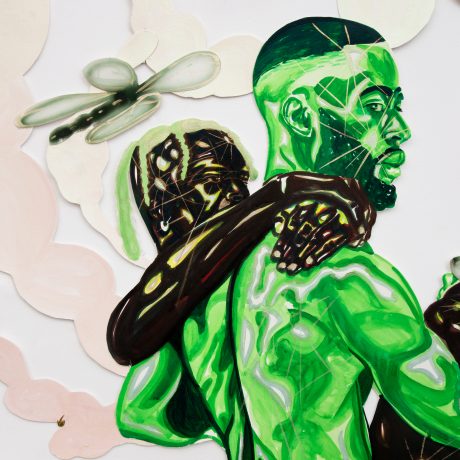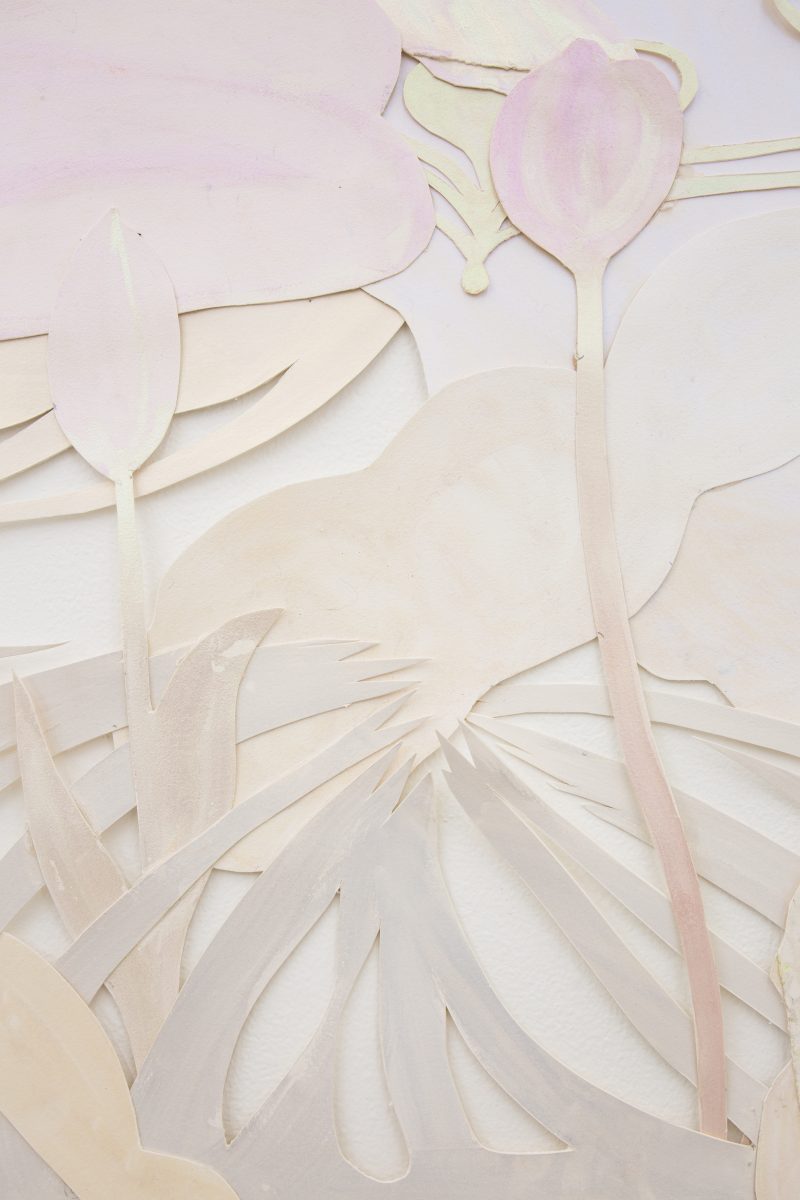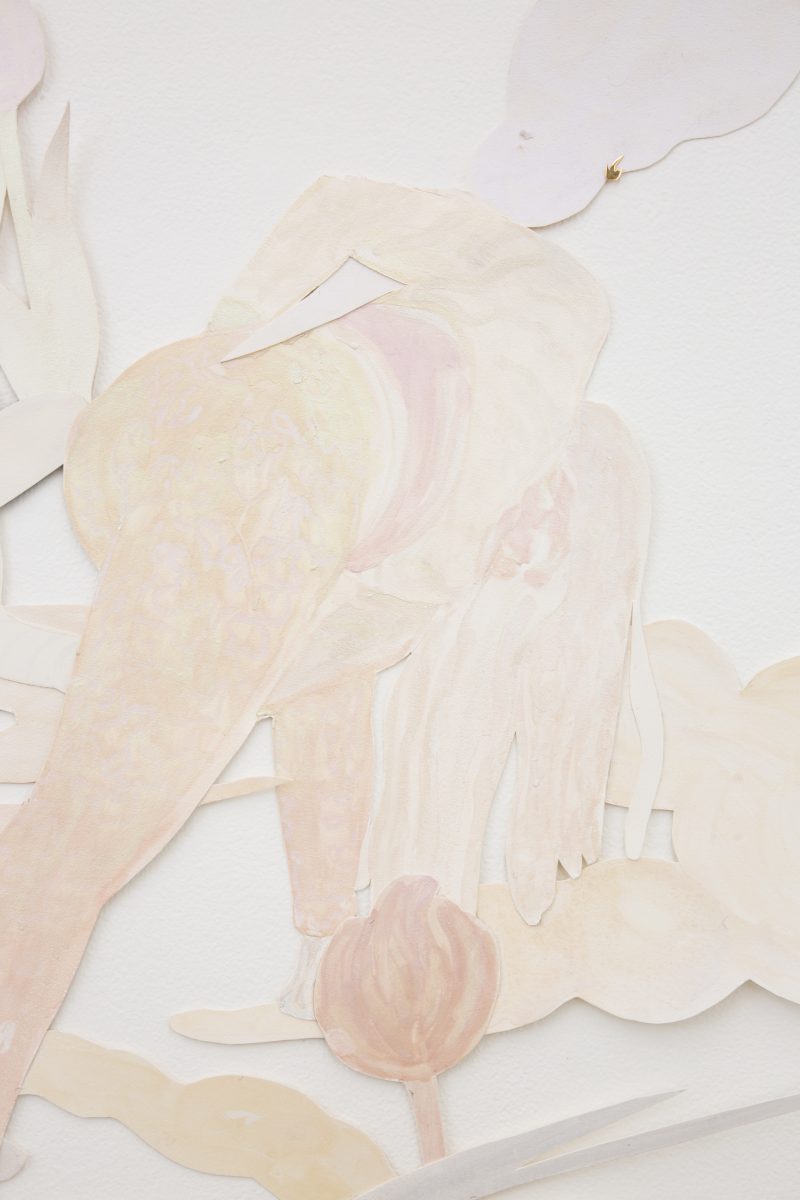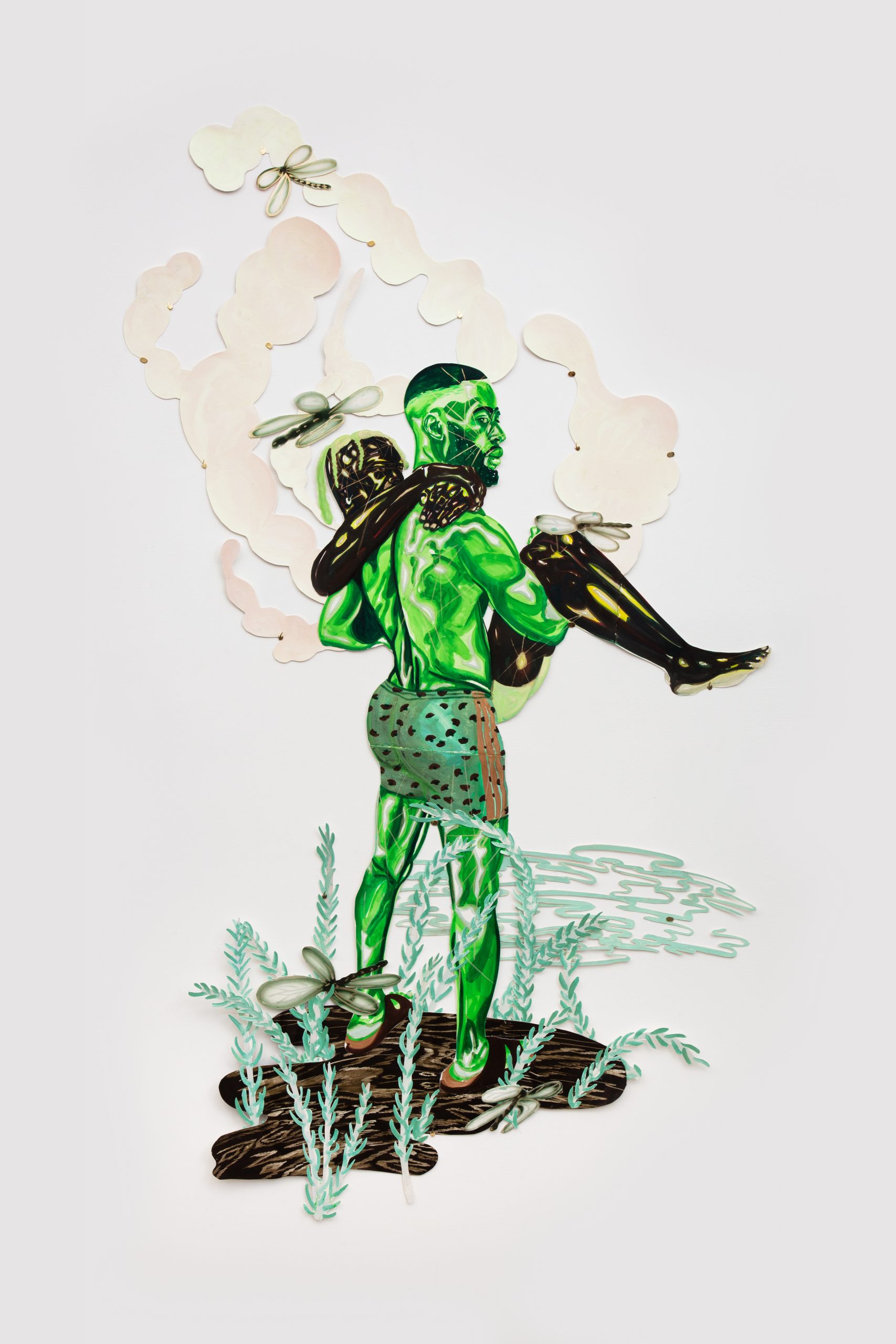
Khari Johnson-Ricks’ work takes friends, peers and interactions from everyday life and stylises them using shellac ink and watercolour on sculpture-like paper figures. Loosely tracing the passage of time across a single day, Feel Me? showcases the artist’s range not just as a painter, but as an observer of social (and often asocial) relations. A friend’s lavish garden is chosen not just for its aesthetic value, but also the time and care put into its cultivation: a scene deserving of attention, a stopping of the clocks to explore life’s moments of serenity.
Based in New Jersey, Johnson-Ricks’ work extends to performance, DJing, murals and zines. An appreciation for narrative storytelling is displayed throughout the show, which runs at Night Gallery in Los Angeles until 1 May. Subjects feel elevated from their everyday settings by his use of colour and selective process: animals and plants are favoured over buildings and bystanders, inviting mystical parallels.

Johnson-Ricks’ ethereal vignettes on clubbing and dissociation accompany the show. One describes a hook-up: “he bent down to kiss my mouth. Our tongues and teeth collided in a soft choreography designed by our lips,” before the speaker dissolves and flees, body parts at once intact for metaphor but suddenly absent. “I wonder how my body could be this fragile, how I could be turned to water so easily. What was all the training for?”
In the second text, friendship is presented as a nurturing state, but one which is heightened when rooted in a respect for self and others:
Look over at your friend.
Are they there?
if they are, smile
if they aren’t, smile

The exhibition text evokes a dystopian assessment of our world. Is that the backdrop against which you’re working?
When I think about the work I’ve made for this show, it’s just like a series of hopeful fantasies or fleeting connections: love letters to friendships that may or may not be slipping in and out of my life.
I’m actually not interested in dystopia. I’m more interested in, I guess, corralling a sort of sanctuary bubble. I’m capturing moments of peace, moments of happiness, fleeting moments of joy in a world that is kind of shit!
In a way, the environments are essentialised. I think: “What are the elements right now in the moment that feel good?” So a lot of the work doesn’t include any man-made architecture other than my own sort of imaginings, you know? It’s pared down in a way the things that expressly feel good for the people, or whatever, in the work.
I include the texts with my work because these kinds of interactions dissolve. The beauty of a weekend retreat: ultimately you know that Monday happens! The works are a way of depicting how those moments could look if they weren’t interrupted. It’s like the moment before an overexposed photograph; before the film goes completely white again, there’s this magical world that shows up: an overexposed fever dream.
“It’s like the moment before an overexposed photograph. There’s this magical world that shows up: an overexposed fever dream”
Looking at Devins Garden, it’s almost a fantastical treatment of Earth. How would you describe this interpretation of ecology?
It’s all about the feeling. Like, what about Devin’s actual garden feels good? It’s facing south in the afternoon; it gets direct sunlight; there are fig trees. There’s a bunch of potted plants that he’s worked on over the years. It’s a project that he’s done for a long time. And when it rains, there’s a rainbow. Like, a proper rainbow. It’s amazing. So, for me, it slips in and out of fantasy. It’s kind of literal, in a way, too. Devin has a garden and there is a rainbow. But how do I capture what that feels like, for me as someone visiting that space?
Instead of trying to replicate what I see, I think, “Okay, what are the elements here? And what feels good to me, being in that space?”

In works like Weekend Retreat, the figures appear as characters rather than subjects: they remind me of cinema. Are you influenced by narrative media?
Movies are really important to me, but I almost see them as literature. Like Yoko Towada or Renee Gladman, sort of vignetted casual storytelling. That’s a thing I’m really interested in. Like Moesha’s diary at the end of [the US sitcom] Moesha: episodic television that doesn’t have a clear through it. Because that’s the way my life really works. There’s this overarching continuity of my own ambitions, but my actual life starts and stops all the time; the interactions I have with my friends are kind of sporadic, you know?
For the paintings, I fabricate stuff. It’s definitely not non-fiction. I just think, “Oh, here’s two people that I really think are fun and interesting.” Or “Devin’s been working on a garden for five years. It’s finally starting to look like a real, like a real-ass garden. Let’s make a painting about that.” It’s about going about my life and using that architecture for fictional stories.
With all my work, there’s an energetic manifestation. In this show, there’s a trajectory from what you can consider the first piece, Dawn, which is this chrome all-white sort of thing. It’s a morning workout, a bunch of friends stretching. And then it ends with a piece that isn’t in the proper show, called Dusk, which is just a friend of mine cooking outside.
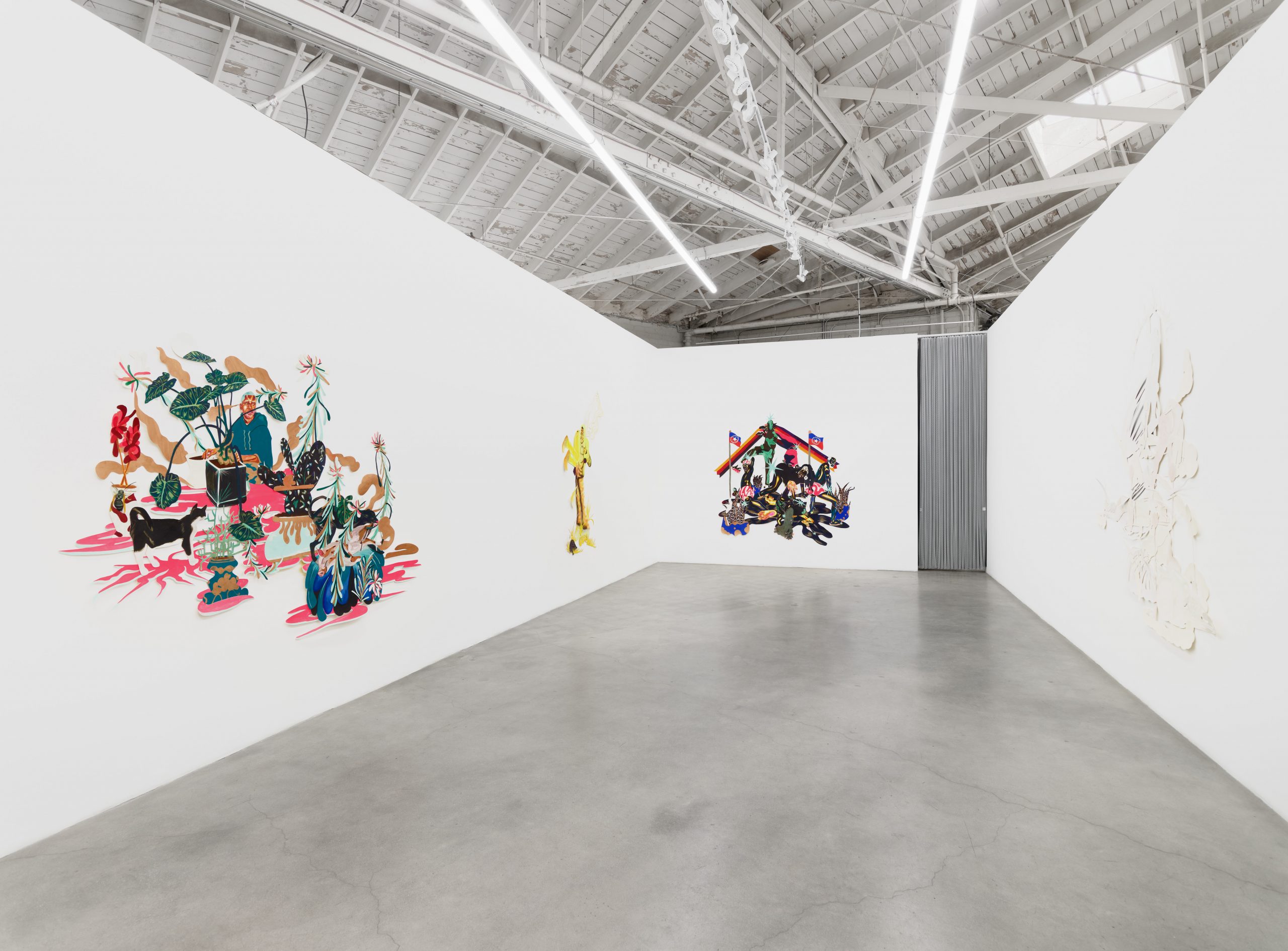
It doesn’t sound like you’re letting viewership or reception determine your practice. Is that fair?
Viewership is a black hole. What I think about is being accountable to the people I decide to paint, because I care deeply about them, and don’t want to make a thing that feels disingenuous to them. If a new person sees the paintings, they’ll realise they’re sincere, I hope.
Beyond that I don’t really care what feelings viewers have. As long as they feel like I’m being honest, that’s the main thing. It’s not like I’m trying to convey or change anybody’s mind.
“I’m capturing moments of peace, moments of happiness, fleeting moments of joy in a world that is kind of shit!”
Gallery spaces play an important role, because you’re almost tracing the works’ edges. How do you think about that relationship?
There’s the essential form, right? How do you make an interesting form out of a painting? There’s that as a sculptural quality. And then you have the pictorial plane, which is only the essentials of building the world: a sky, a ground, a subject, right? And then whatever they’re doing; whatever the objects are that help to delineate what’s happening. Then you have an atmospheric that might denote smoke or air or cloud, or something like that.
I don’t really care about other stuff, like background and people. If I’m taking a picture of a friend doing something, I don’t really give a fuck if someone is carrying their groceries in the background. I’m more interested in animals than I am in other people. That’s more fun and more interesting to me to depict than trying to fill a proverbial camera lens.
On the technical side, for me, I’ve got an animation background. I come from thinking, “Okay, let’s just layer this shit like Photoshop.” We need two trees, we need this many of that element, that many of that element and let’s just put them together. And if something doesn’t work, take it out. Let’s make decisions about what the work actually needs.
